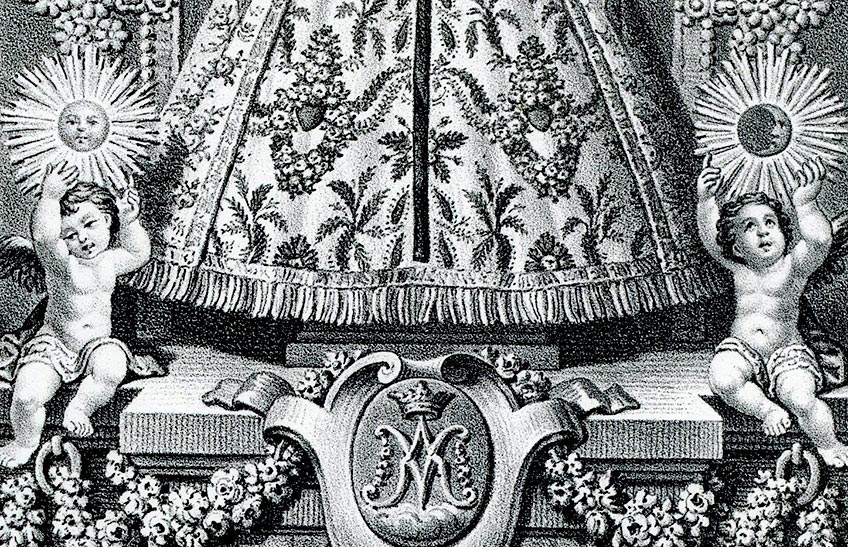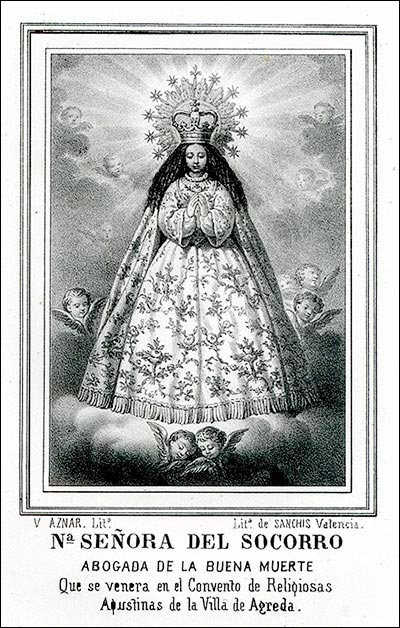Valencian lithographs of the Virgen del Socorro of Ágreda

PhotoCedit/Detailof the lithograph of the Virgen del Socorro of Ágreda
In 1865, a canon of the cathedral of Valencia born in Ágreda, Don Melitón Gómez, ordered and paid for two lithographs of the Venerable María Jesús de Ágreda, one as evangelizer in New Mexico and another one with her genealogical tree. This was so stated in the inscriptions of the large plates. Undoubtedly at that same moment it was done position to entrust to the same artists that had made the previous ones, other engravings with destiny to the Soria locality, concretely that of the famous Virgin of the Choir of the Conceptionists and of the Virgin of the Help of the Augustinian Sisters of the same locality, that occupies us. All were the work of Vicente Aznar Procar, painter and lithographer, born in Valencia in 1835 and died in the same city in 1895. He was a disciple of the San Carlos School in the city of Turia, where he won several prizes. In the Regional exhibition of 1867, he presented, with great success, a print of Our Lady of the Forsaken that was very applauded.
The printings of all these Agredan icons were made in the lithographic establishment of Nicolás Sanchís.
The promoter of the stamp was, undoubtedly, Don Melitón Gómez, born in the Soria town in 1810. The parish priest of Agreda judged him, in his seminary days, as "humble and with inclination to the ecclesiastical state, without vices, retired and little boisterous in the classroom and in the church". In 1828 he received the clerical tonsure. In 1831 he appears as a relative of the Oratorian Bishop Pablo García Abella, titular of Tiberiopolis and auxiliary of Madrid, following the ecclesiastical programs of study in the high school of Santo Tomás de la Corte. In 1832 he was ordained subdeacon and in 1833 as a priest, in this case by the same bishop, then titular of the calagurritana silk, to which he served as a relative. He had a brother, named Felix, who also embraced the ecclesiastical state and became a canon of Valencia. The prelate who protected these Agredano canons, Don Pablo García Abella (1776-1860), occupied the mitre of Calahorra between 1835 and 1848, although he was exiled by the liberal governments between 1837 and 1848. In the latter year he was preconized archbishop of Valencia, the city where he died in 1860.

Lithograph of Nuestra Señora del Socorro de Ágreda, by Vicente Aznar, c. 1865.
On the registration of the print, which measures 310 x 213 mm, we read: "V. AZNAR Litº Litª de SANCHIS. Valencia / NUESTRA SEÑORA DEL SOCORRO / ABOGADA DE LA BUENA MUERTE Y FELICES PARTOS / Se venera en el Convento de Religiosas Agustinas de la Villa de Ágreda / Por rezar una Salve ó Ave María tiene muchas indulgencias / de varios prelados".
There is another smaller version (215 x 152 mm.), the work of the aforementioned Aznar and Sanchís, very similar to the previous one but more simplified, with a lighter apron in decoration, without the pedestal and the angels with the sun and the moon and without the semicircular arch with large bouquets of flowers. The registration, more abbreviated than in the larger print, reads as follows: "V. AZNAR litº. Litª of SANCHIS. Valencia / Nª SEÑORA DEL SOCORRO / ABOGADA DE LA BUENA MUERTE / Que se venera en el Convento de Religiosas / Agustinas de la Villa de Ágreda".

Another lithographic version of Nuestra Señora del Socorro de las Agustinas de Ágreda, c. 1865, by Vicente Aznar.
The image and a trompe l'oeil of the eighteenth century
The Virgen del Socorro was a well-known image of the convent of Augustinian Recollect Nuns of Agreda, founded in 1660 with nuns from Valladolid. The Augustinian chronicler Alonso Villerino gives us an account of its Valladolid origin, as well as marvelous legends about the Marian icon, in these paragraphs: "There is in this convent an image, whose vocation is Our Lady of Help, it was made in Valladolid, and at the time of being made, the Recollect mothers of the convent of that city made many prayers, begging the Lord with efficacy, that he be served so that it would come out very beautiful. The efficacy of the prayers of the convent began to be known, because the master who was making it, many times assured that when the instruments with which he was working fell to the ground, without getting down for them, or knowing how, he found them again in his hand. At the same time it was revealed to a nun of the said convent, that the sculptor who made it, was assisted by six angels all the time he made it and offered it to this nun Our Lord, that his Blessed Mother would assist in the face of that holy image very ordinarily. And what is certain is that the beauty of the face of this image is such that it seems to testify that it is the effect of sovereign attendance. To a priest who attended with great zeal to the foundation of the convent of Ágreda, it appeared to him twice, in a serious illness that had this holy image and he got whole health with so sovereign attendance. The nuns of this convent unanimously assure that, in the days of the Assumption, Incarnation, Conception and their octaves of these mysteries, they recognize, to what they reach, that in the face of this image extraordinary lights reverberate, seeming greater its beauty, than the ordinary one. The same they say that it has appeared to different ecclesiastical persons outside of religion on the aforementioned days. They also repaired, that the face of the image is recognized this greater beauty when some religious dies in the convent, although with difference, because in the death of some, is greater beauty that they seem to recognize, than in that of others".
Apparently, according to some testimonies that are not proven by documents, the image suffered great damages as a result of a fire, after which it was totally remade, with degree scroll and invocation of the Consolation, as it is venerated in a collateral of the church of the mentioned convent. If the transformation really existed, the position of the hands was modified -before together, at waist level holding a bouquet of colorful flowers and a long seam in the center of the apron that seems to represent the Augustinian strap-, while her clothing was simplified with a large tunic and mantle, eliminating the traditional bodice and skirt.
Along with the delicate lithographic prints, other representations of the Virgen del Socorro are known. Specifically some trompe l'oeil painted on canvas, where the figure appears dressed in the eighteenth-century style, with a funnel-shaped skirt and a bodice with a narrow waist. The typical rostrillo with two jewels of the Virgin of Pilar and the cross of Caravaca and an imperial crown with a flurry constitute her headdress. The fabric of her clothes is the one used in the Hispanic spurs of the time, with rich flowers of vivid colors. The large silver crown was stolen by the French in 1808, along with other valuable pieces of the convent.
A lower registration in small letters identifies it in one of the trompe l'oeil paintings as the "miraculous image" of the Virgen del Socorro de las Agustinas de la Villa de Ágreda. It is possible that these trompe l'oeil paintings are the work of the painter Miguel Pimpinela, who painted the great canvas of the old main altarpiece of the church of the convent, with the topic of the Assumption of the Virgin, the lower part of which conserved the doorway, with the corresponding signature. The spelling of the latter is similar to the registration of the painting to which we refer. The chronology of the painting will be adjusted to the stay of the aforementioned painter in these lands, which must not have been very different from his presence in neighboring Navarre, where it is documented in 1725, specifically in Sangüesa, to decorate, in fresco, the dome of the chapel of San Román in the parish church of Santiago.
To find out more
ALDANA FERNÁNDEZ, S., guide abreviada de artistas valencianos, Valencia, Ayuntamiento, 1970, p. 37.
FERNÁNDEZ GRACIA, R., Iconography of Sister María de Ágreda. Imágenes para la mística y la escritora en el contexto del maravillosismo del Barroco, Pamplona, CajaDuero, 2003, p. 189.
LABEAGA MENDIOLA, J. C., "Notas para la historia del arte de las iglesias de Sangüesa", Príncipe de Viana (1990), p. 821.
OLMOS Y CANALDA, E., Los prelados valentinos, Madrid, high school Jerónimo Zurita, 1949, pp. 300-307.
PEÑA, M., "Ágreda 1808-2008. En la invasión napoleónica", Programa de fiestas de Nrª Srª de los Milagros, 2008, s/p.
VILLERINO, A. de, Esclarecido solar de las Religiosas Recoletas de Nuestro Padre San Agustín y vidas de las Insignes hijas de sus conventos, vol. II, Madrid, Imprenta de Bernardo de Villa Diego, 1691, pp. 132-133.
